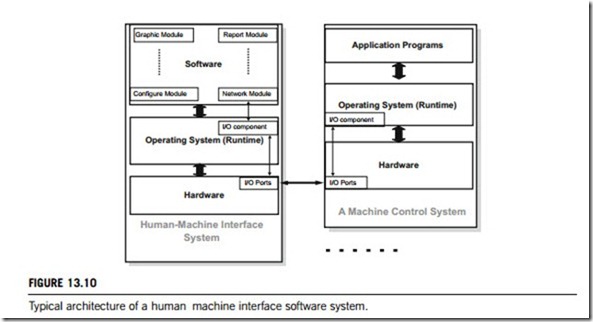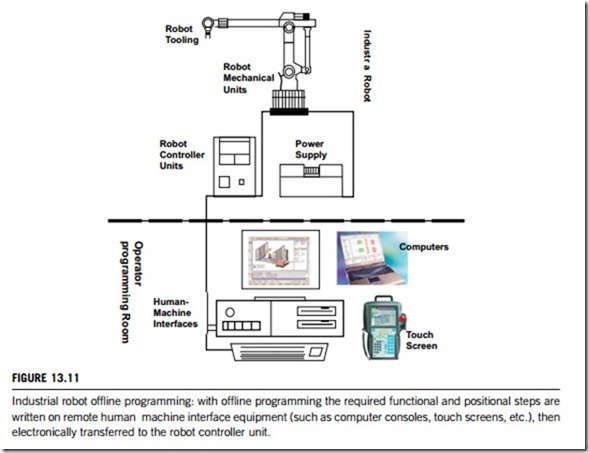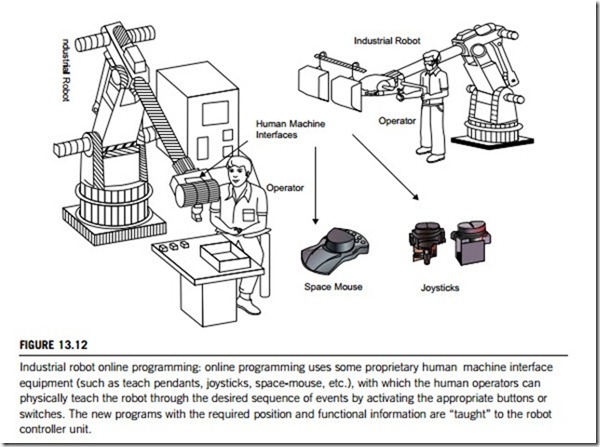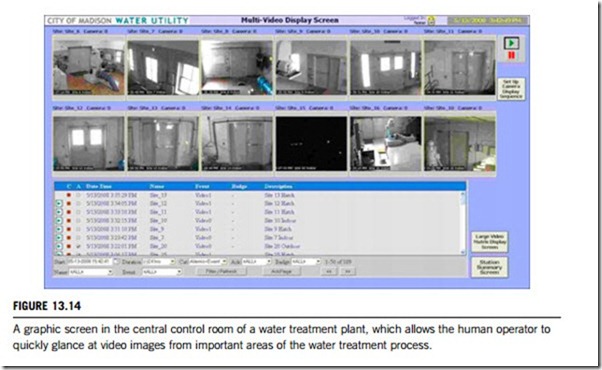INDUSTRIAL APPLICATION EXAMPLES
Over recent years, there have been many developments in industrial control and automation systems which have led to human machine interfaces becoming a necessary component of most industrial control and automation systems. Two important examples in this respect are the human robot inter- faces in industrial robots, and the human machine interfaces in SCADA systems.
Human–machine interfaces in robotic systems
A human machine interface in a robotic system is a terminal that allows the human operator to control, monitor, and collect data, and can also be used to program the system.
Sometimes the human machine interface can be built into the mainframes of the robotic systems. This kind of human machine interface can be a computer screen, pendant consoles, spin buttons, and arm sticks. However, the interface may also go through a chain of devices that on one side convert human-intelligible commands into robot commands and on the other side convert robot feedback into human-understandable information. At the beginning of the chain (close to the human operator) there is a robot control station equipped with a series of human machine interfaces, at the other end there is a robot controller.
Different human machine interfaces are needed to deal with different types of involvement of the human operator. For programming activities, the consolidated human machine interfaces of computer consoles are adequate; for advanced programming involving interaction with three-dimensional computer models, joysticks and a space-mouse could be used; for limited teleoperation, a set of joysticks has traditionally been used; for advanced and immersive teleoperation with force feedback, master-arms and Exoskeletons are the best choice While performing any robot operation, a human operator may interact with the robot in degrees ranging between two extremes: no interaction and constant interaction. The two control models associated with these extremes are:
1. Offline robot programming, in which everything that the robot is asked to do is encoded in a program (in a suitable task-description language). This program is to be downloaded via proprietary interface equipment. Available equipment for industrial robot offline programming include proprietary computers (PC, desktop, and laptop computers), handheld terminals, and so on. Figure 13.11 illustrates the model for industrial robots.
2. Online robot programming, in which a human operator drives (or teaches) the robot through its tasks by means of suitable human computer interface equipment. An operator doing the teaching has physical contact with the robot’s human computer interface or arms to actually
gain control or perform the teaching functions within the working envelope. The human machine interface equipment in the market for industrial robot online programming include teach pendants, robot arms, and joysticks or space-mouse for teleoperation. Figure 13.12 illustrates the online programming model for industrial robots.
Offline programming is suited to applications where the same operation is repeated in a well-known non-changing environment, whereas online programming suits applications where variation of the operation and an unknown or unpredictable environment are present, hence requiring continuous human judgement.
Human–machine Interfaces in SCADA systems
The human machine interface is an essential component of any SCADA system, to perform supervisory controls and data acquisition. It presents the information to the human operator graphically, mostly in the form of mimic diagrams. Mimic diagrams may consist of line graphics and schematic symbols to represent process elements, or may consist of digital photographs of the process equipment
overlain with animated symbols. This means that the operator can watch a schematic representation of the devices and processes being controlled so as to monitor them efficiently.
A human machine interface of a SCADA system is the graphic apparatus, which mainly refers to computer screens and TV consoles, but can also be specially built industrial programmable controllers such as CNC (computer numerical controller), or PLC (programmable logic controller) devices, as shown in Figure 13.13. The interface is usually linked to the databases and software of a SCADA system, to provide status, trending, diagnostic data, and management information.
The human machine interface package for a SCADA system typically includes a drawing program to allow operators to change the way these points are represented in the interface. These representa- tions can be as simple as an on-screen traffic light, which represents the state of an actual traffic light in the field, or as complex as a multiple-projector display representing the position of all of the elevators in a skyscraper or all of the trains on a railway.
In water treatment plants, where tanks, lagoons, pumping stations and other equipment are spread over a wide area, camera images can make sure that valves open and close, lagoons are at the right level, and a child has not fallen into the lagoon. Video not only provides process information, it can mitigate liability and provide security. With these videos, a human operator at a central control room can know whether to take a shotgun or a wrench to the field to fix a stuck valve.
Figure 13.14 shows a human machine interface screen at a water treatment plant. If a video image of the process unit appeared on the screen when an exception occurred, the human operator at a central control room would be able to immediately see what was happening.
At present, many SCADA networks are almost hack-proof, accident-resistant and control-reliable because of their human machine interfaces. Figure 13.15 shows a SCADA network designed to handle
digital communications between industrial controllers and computers, which can easily accommodate video images, too. The cameras use the bandwidth available in most SCADA networks to report video information to the host system for real-time diagnostics and handles.





